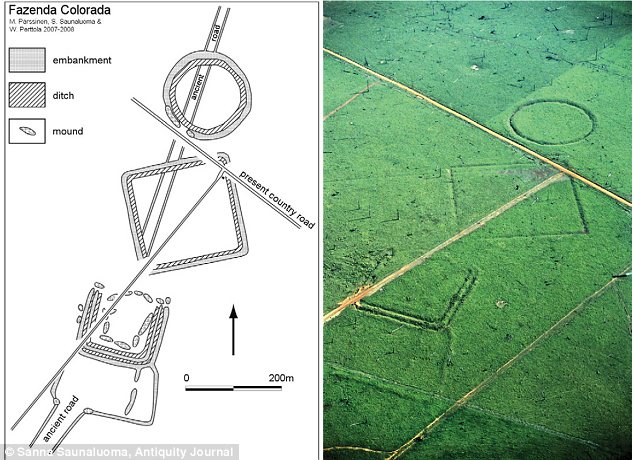Archaeologists have found more than 200 earthworks shaped as perfect circles and squares, many connected by straight roads. They have dated one site to 1283AD but say others could be from as early as 200AD.

The earthen foundations were found in a region more than 150miles across, covering northern Bolivia and Brazil's Amazonas state.
The first ones were uncovered in 1999, after large areas of pristine forest was cleared for cattle grazing.
Sculpted from the clay rich soils of Amazonia, the earthworks are made up of 30ft wide and 10ft deep ditches alongside 3ft high walls. The largest ring ditches founds so far are 1,000ft in diameter.
The structured earth mounds or 'geoglyphs' can now be spotted against the treeless, savanna-like landscape and scientists have compiled an archive using Google Earth.
A team of researchers have analysed all the findings in a paper published in the journal Antiquity.
They found that most earthworks were clustered on a 200m high plateau at the top of river valleys. This would have given inhabitants a defensive advantage with a clear view of people coming up river. Most were also placed near spring water sources.

Co-author Denise Schaan from Federal University of Pará in Brazil, said: 'Whether the sites were purely ceremonial or defensive, it is clear that the area was densely populated by relatively sedentary people at the eve of European contact.'
Ms Schaan said they estimated at least 300 people would be needed to build a geoglyph when taking both workers and domestic helpers into account. This points to a regional population of around 60,000 people.
She added that nearly ten times as many earthworks may exist undetected under the remaining forest.
Excavations at some sites have also revealed evidence of permanent habitation, including domestic ceramics, charcoal and grinding stone fragments.
The findings cast serious doubt on previous studies that stated the area could only support small, impermanent villages.
Instead it is likely the Amazon teemed with complex societies. These were probably wiped out by diseases brought to South America by colonists 500 years ago.



Are why you don't probably find ancient buildings there. Amazon has had a lot of trees and other organic material to use for building, and I don't think they've needed much insulation so they didn't have to worry so much about the windy creeks like us northern people. Anyways, don't expect any wood-made stuff to last long in places like Amazon, because there's a lot of greenery and greenery and life, and that eats away much of the possible evidence, especially if it's made from more living materials like tree.